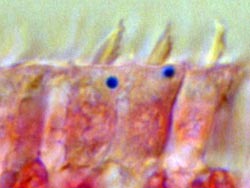Bird Navigation – Great Balls of Iron

A image showing cells from the inner ear of pigeons stained with a chemical that turns iron bright blue in colour. It highlights the balls of iron discovered by the Keays lab. Each ball of iron lies directly beneath the hairs, and there is just one per a cell. IMP<br>
Their work, published in Current Biology, reports the discovery of iron balls in sensory neurons. These cells, called hair cells, are found in the ear and are responsible for detecting sound and gravity. Remarkably, each cell has just one iron ball, and it is in the same place in every cell.
“It’s very exciting. We find these iron balls in every bird, whether it’s a pigeon or an ostrich” adds Mattias Lauwers who discovered them “but not in humans”. It is an astonishing finding, despite decades of research these conspicuous balls of iron had not been discovered.
This finding builds on previous work by the lab of David Keays who last year showed that iron-rich cells in the beak of pigeons that were believed to be the magnetic sensors, were really just blood cells. “These cells are much better candidates, because they’re definitely neurons. But we’re a long way off to understanding how magnetic sensing works – we still don’t know what these mysterious iron balls are doing.” said Dr Keays. “Who knows, perhaps they are the elusive magnetoreceptors” muses Dr Keays “only time will tell”.
The paper “An Iron-Rich Organelle in the Cuticular Plate of Avian Hair Cells” (Lauwers et al.) is published online by Current Biology on April 25, 2013.
Illustrations to be used free of charge can be downloaded from the IMP-Website: http://www.imp.ac.at/pressefoto-magnetoreceptor
About the IMP
The Research Institute of Molecular Pathology (IMP) in Vienna is a basic biomedical research institute largely sponsored by Boehringer Ingelheim. With over 200 scientists from 30 nations, the IMP is committed to scientific discovery of fundamental molecular and cellular mechanisms underlying complex biological phenomena. Research areas include cell and molecular biology, neurobiology, disease mechanisms and computational biology.
Scientific Contact
Dr David Keays
Phone: +43 (0)1 79730-3530
Mobile: +43 (0)699 19071544
e-mail: keays@imp.ac.at
Press Contact at the IMP
Dr. Heidemarie Hurtl
Communications Manager
Tel. +43 (1) 79730-3625
Mobil: +43 (0)664 8247910
e-mail: hurtl@imp.ac.at
Research Institute of Molecular Pathology
Dr. Bohr-Gasse 7
1030 Vienna
Austria
Media Contact
All latest news from the category: Life Sciences and Chemistry
Articles and reports from the Life Sciences and chemistry area deal with applied and basic research into modern biology, chemistry and human medicine.
Valuable information can be found on a range of life sciences fields including bacteriology, biochemistry, bionics, bioinformatics, biophysics, biotechnology, genetics, geobotany, human biology, marine biology, microbiology, molecular biology, cellular biology, zoology, bioinorganic chemistry, microchemistry and environmental chemistry.
Newest articles

Properties of new materials for microchips
… can now be measured well. Reseachers of Delft University of Technology demonstrated measuring performance properties of ultrathin silicon membranes. Making ever smaller and more powerful chips requires new ultrathin…

Floating solar’s potential
… to support sustainable development by addressing climate, water, and energy goals holistically. A new study published this week in Nature Energy raises the potential for floating solar photovoltaics (FPV)…

Skyrmions move at record speeds
… a step towards the computing of the future. An international research team led by scientists from the CNRS1 has discovered that the magnetic nanobubbles2 known as skyrmions can be…





















